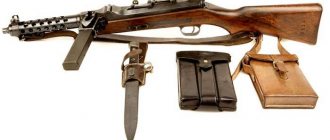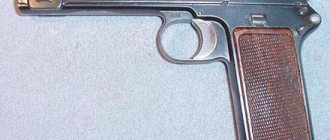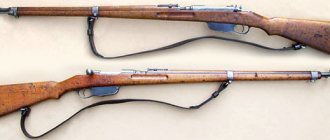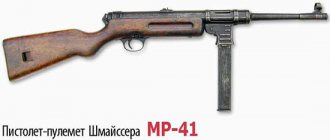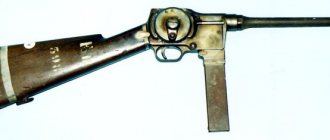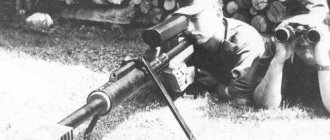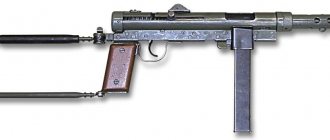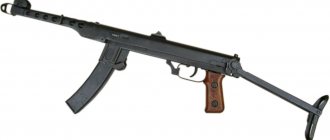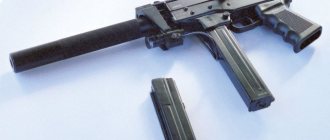| MP.35 | |
| MP.35 with spare magazine and pouch | |
| Type | submachine gun |
| A country | Nazi Germany |
| Service history | |
| Years of use | 1935-1970 |
| Adopted | 1935 |
| In service | Wehrmacht |
| Wars and conflicts | World War II, local wars 1930-1960. |
| Production history | |
| Constructor | Emil Bergmann |
| Designed by | 1932 |
| Manufacturer | Bergmann |
| Years of production | 1935-1940 |
| Options | BMP32, Bergmann MP34 |
| Characteristics | |
| Weight, kg | 4.24 (unloaded) |
| Length, mm | 840 |
| Barrel length, mm | 200 |
| Cartridge | 9×19 mm Parabellum |
| Caliber, mm | 9 |
| Work principles | blowback (shooting is carried out from an open bolt) |
| Rate of fire, rounds/min | ~600 |
| Initial bullet speed, m/s | ~370-380/420-430 (barrel 200/320 mm.) |
| Sighting range, m | 150—200 |
| Type of ammunition | box magazine for 20/24/32 rounds |
| Aim | sector |
Not to be confused with the German MP34 - an Austrian submachine gun. MP.35
(German:
M
aschinen
p
istole 35 - submachine gun model 1935) is a German submachine gun designed by Emil Bergman based on the design of the BMP-32 submachine gun (Bergmann-Maschinen-Pistole 32) model 1932.
History[ | ]
After selling the rights to produce MP.18 to the Swiss concern SIG, Emil Bergmann in 1932 developed a new version of the BMP32 submachine gun, the prototype of which was manufactured by the Danish company Schultz & Larsen[1]. In Denmark, the weapon continued to be produced in the original BMP32 version in the 9x23 mm Largo caliber[2].
In 1934, based on the BMP-32 design, a more advanced version of the BMP-34 (or MP.34/I)
), mass production of which was carried out at the Carl Walther factory. In total, about 2000 pieces were produced. in calibers 9x19 mm Luger, 9x23 mm Largo, 7.63x25 Mauser, .45 ACP, 9x25 mm Mauser Export [1]. The main consumers of the MP.34/I were the German police and the Bolivian army[2].
The submachine gun was produced with a long (320 mm) or short (200 mm) barrel, equipped with a compensator. The barrel could be easily removed. Some models allowed the attachment of a bayonet. The sector sight had markings from 50 to 1000 m in increments of 50 m. A magazine with a capacity of 16, 24 and 32 rounds was attached to the right side of the weapon (like the SIG modell 1920)[3].
In 1935, a modified version of the BMP-35 (or MP.35/I)
). From 1935 to 1940 - 5000 MP35s were produced[4]. It took part in the Spanish Civil War, was purchased by Ethiopia, and in 1939, under the designation “m/39”, was adopted by Sweden[2].
Having appreciated the good reliability and accuracy of the weapon, Waffen SS contributed to the transfer of the license for the production of MP.35/I to Junker & Ruh AG. Production began at the end of 1940 and continued until 1945. In total, about 40,000 units were produced, mainly for the needs of the Waffen SS[2].
blowback
The operation of the MP 18 mechanisms is based on the blowback recoil principle. The production quality of the MP 18 was quite high, the stock was made of wood, and the 32-round magazine was inserted on the left side. A perforated air cooling casing was made on the barrel. Shooting was carried out only in automatic mode.
When Germany was disarmed after 1919, the MP 18 was handed over to the police in the hope of preserving the concept. In the 1920s, the model was modernized: instead of a “snail” magazine, as on the Luger pistol, they made a regular straight box magazine. In 1928, the MP 18 began to be produced in limited quantities again in Germany under the designation MP 28.
New sighting devices were installed on it, the ability to conduct single fire was made possible, minor changes were made to the design of the bolt and a bayonet mount was installed. MP 28 was supplied to many countries around the world, and its licensed production was organized in Belgium and Spain.
Description[ | ]
The Bergmann submachine guns models 34 and 35 were developed by designer Emil Bergmann based on the old technical documentation of the MP.18; in appearance they were similar to the Schmeisser samples, but differed from them not only in the right-hand location of the magazine, but also in a number of design features[5].
The MP.35 submachine gun uses a blowback system and fires from an open bolt. A distinctive feature of the weapon is the cocking handle; it is located at the rear end of the bolt box and repeats the cocking of the bolt of a Mauser rifle. When firing, the bolt handle is motionless. The fuse was on the left side of the bolt box. Fire modes: single shots or automatic fire. The weapon had a front sight and a sector rear sight, marked from 100 to 500 meters[4]. Partial pressing of the trigger gave a single shot, and a full press gave automatic fire[6].
Submachine gun Steyr Solothurn S1-100 / MP-34 (Switzerland / Austria)
The submachine gun was developed in the early 20s of the last century. To circumvent the restrictions of the Treaty of Versailles on the production of weapons, the production of submachine guns was launched in Switzerland, in which the German company owned a controlling stake. In 1929, the Austrian company (“Waffenfabrik Steyer”) acquired a license to produce submachine guns. In 1934, the submachine gun was adopted by the Austrian army and gendarmerie under the name Modell 34. Army submachine guns were adapted to fire 9-mm “long” Mauser cartridges. For the police version, 9-mm cartridges from the Steyr pistol were used. 1912 After minor modifications, the Rheinmetall submachine gun received the designation Solothurn S1-1 00.
In addition, submachine guns were produced chambered for the 7.63 mm Mauser cartridge for supplies to Japan and for 9 mm Parabellum cartridges supplied to Yugoslavia and Portugal. After the annexation of Austria to Germany in 1938, submachine guns were produced chambered for and only chambered for the 9-mm Parabellum cartridge. In Germany, the submachine gun received the index MP-34 with the addition of the letter “o” if the weapon was intended for Austria. Production of submachine guns did not continue until about 1940.
Well-known foreign sources do not name the inventor of the submachine gun, but structurally the Solothurn S1-100 is very similar to the Rheinmetall MP-19 submachine gun, developed in 1919 by Louis Stange. Comparing these two samples, we can assume that they were developed by the same designer and that the Solothurn S1-100 is essentially an upgrade of the MP-19.
Their main common features are a massive wooden stock with a semi-pistol neck, a cylindrical barrel casing with round ventilation holes, a magazine located horizontally on the left, a return spring in the butt, a bolt box cover rotating up and down, etc.
The horizontally located magazine is convenient when shooting prone in open areas, and the location of the return spring in the butt allows you to shorten the length of the bolt box; the rotating cover makes it easier to clean the internal surfaces of the bolt box, cover, and barrel.
The automatic operation of the Solothurn S1-100 submachine gun is based on the recoil principle of a free massive bolt. The bolt has a rigidly mounted firing pin and a large reloading handle protruding onto the right side of the weapon. A lid is attached to the rear end of the shutter with a cracker joint, to which a long rod is attached with the help of an axis, which has the ability to swing in a vertical plane. Through this rod, the bolt acts on a recoil spring located obliquely in the butt.
The cartridges are fed from a box magazine with a staggered arrangement of cartridges and a double-row exit. The magazine neck is milled integrally with the lower half of the bolt box. MP-34 submachine guns, this neck has a device that allows you to load a magazine from the cartridge clip of a Steyr pistol mod. 1912. For this purpose, the lower part of the neck has a device for attaching the magazine, and in the upper - opposite - part of the neck, guide grooves are milled for installing the clip. The cartridges are squeezed out of the clip with your thumb into the magazine.
The lower half of the bolt box and the cylindrical barrel casing are a single piece. The axis of the rotating cover of the bolt box is located at the neck of the magazine. The internal surfaces of the bolt box and its cover are cylindrical; the outside of the cover is milled in the form of several longitudinal edges. The internal surfaces in contact with the bolt are chrome-plated; the outside of these parts, as well as the barrel casing, are polished and chemically oxidized. The stock of the submachine gun was made of wood, the barrel was enclosed in a round perforated casing, which had a mount for a bayonet.
Sights include an adjustable front sight and a sector sight. The front sight with side protective posts is mounted on the front of the barrel casing. The base of the sight with the aiming bar is mounted on the cover of the bolt box. On the sighting bar, markings are marked every 50 meters for shooting at distances from 50 to 500 meters.
Shooting is done from the rear sear. The trigger mechanism allows firing with single fire and bursts. The fire mode is set by a switch located on the left side of the forend. The engine moves along a steel bar embedded in the forend and secured with two screws. When the engine is moved forward all the way, the trigger mechanism is set to the position for continuous fire. In this position of the engine, the letter “O” opens on the bar. To fire a single fire, the engine is moved back all the way, and the letter “E” opens on the bar.
From the point of view of production and practical use of the MP-34 submachine gun, this device, which significantly increases the cost of its production, is unnecessary, since at a rate of fire of 450 rounds per minute, it is not difficult for even a poorly trained shooter to cut off the first shot of a burst.
The mechanism for protecting the weapon from unauthorized firing is located on the cover of the bolt box in front of the sector sight. This is a button that can be pressed to lock the shutter in the extreme forward or extreme rear positions. When the button is pressed, the force of the leaf spring is overcome, and a slide with a locking latch is used to hold the button in the recessed position.
A button of a similar shape is located on the cover of the bolt box near the butt plate. This button locks the lock of the bolt box cover. To move the lock, you must first press this button. After opening the cover to partially disassemble the weapon, you can remove the bolt. The return spring remains in the butt.
Steyr Solothurn S1-100 / MP-34 submachine guns were distinguished by very high quality workmanship, high reliability, survivability and shooting accuracy. Their main disadvantage was the high labor intensity of production and, as a consequence, high price. Characteristics Steyr Solothurn S1-100 / MP-34 Caliber and type of cartridges 9×19 mm, “parabellum” Weight of the submachine gun with an empty magazine for 32 rounds, kg 4.7 Length of the submachine gun, mm 805 Rate of fire, rds/min (average) 400-450 Bolt weight, kg 0.95 Bolt stroke, mm 80 Barrel length with chamber, mm 207 Initial speed, m/s (average) 380 Sighting range, m up to 500
In service[ | ]
- Denmark - in 1932, a submachine gun chambered for 9x23 mm was adopted by the Danish army under the name BMK 32
, and its mass production began. In total, about 2,000 Danish weapons were produced; after the occupation of Denmark in 1940, the weapons were at the disposal of the German occupation authorities[7]. - Germany: officially adopted by the Wehrmacht[8][9], in 1939 the majority were transferred to the SS troops, a few more to the German police[10]
- Bolivia: a number of MP.35s have been purchased[9]
- Ethiopia: in 1936, a small batch of MP.35/I was purchased from Germany, they were used during the Italo-Abyssinian War[8][9]
- Sweden: in 1939 MP.35/I was adopted by the army under the name M/39[9]
- Israel: some quantity was supplied in 1947-1950. Used to a limited extent by the IDF and the police until 1972-1975.
- Switzerland: in service until the early 1970s.
- France: Used by the army and Foreign Legion until the early 1970s.
Reliability
The model was highly reliable. This was greatly facilitated by the fact that the cocking handle was located at the back, and not at the side, that is, there was no cutout through which dirt could get inside. This attracted the attention of those who later became the main consumer of the MP 35 - the SS troops, who even in their weapons tried to be different from the rest of the German army.
From the beginning of the 1940s, all production of the MP 35 was intended only for the SS troops, it continued throughout the war and only ceased in 1945. This weapon can still be found in service with police forces in South American countries. The reason for their long service is the high quality of production. Most of the parts are machined from solid pieces of metal.
Finnish submachine gun "Suomi"
The Finnish submachine gun "Suomi-KP M/31" was distinguished by very high quality workmanship. It weighed 4676 g, as many parts were all metal. As a result, the weapon was very reliable and remained in use for many years.
The Finnish Suomi-KP submachine gun model 1931 was produced in Finland and under license in Denmark, Sweden and Switzerland and was widely exported. It was developed by Finnish gunsmith Aimo Lahti between 1920 and 1930. Suomi proved its very high combat effectiveness during the Winter War of 1939-1940, when Finland was attacked by the Soviet Union. The fire of submachine guns with 71-round magazines often prevented Soviet soldiers from raising their heads. In 1944, production of the Suomi was discontinued in Finland, but the weapon continued to be used until the 1990s, when it was replaced by an assault rifle.
A Finnish soldier in a trench on the Eastern Front holds a Suomi with a 20-round magazine in his hand.
Italian MAB 38
The Italian MAB 38 submachine gun was produced by the Beretta factory in Brescia. Until 1943, only airborne paratroopers, carabinieri and police officers in Italian Africa were armed with it. Over time, it became a common weapon in the Republic of Salo (a fascist state in Northern Italy that existed from 1943 to 1945), among partisans and in Italian units fighting under Allied command. The modified version of the MAB 38/42 was lighter, shorter and had a higher rate of fire. It remained in service with the police and carabinieri until the 1970s.
The Italian Beretta MAB 38/42 submachine gun was equipped with magazines for 20 or 40 rounds. The rate of fire was 550 rounds per minute
Submachine gun "Marlin"
The American 9 mm submachine gun, which became widely known as the Marlin, but was officially designated the United Defense M42, was developed in 1941-1942. Carl J. Suibilius, designer of the High Standard Manufacturing Company. The first YUD M42 submachine guns were manufactured by this company to order from Holland and most of them were sent to the Dutch East Indies just before the Japanese invasion. The remaining 15,000 submachine guns were purchased by the US government and were used primarily by operatives of the Office of Strategic Services (OSS) and were also sent to the Resistance movement, especially on the island of Crete. The YuD M42 was a fairly complex but well-made weapon with a twenty-round magazine. For quick reloading, magazines, unusual for that time, were issued, fastened with a “jack”.
The YuD M42 submachine gun, also called “Marlin,” was equipped with 20-round magazines that could be connected in pairs. The rate of fire was the same as that of the Thompson Ml and M1A1 - 700 rounds per minute
